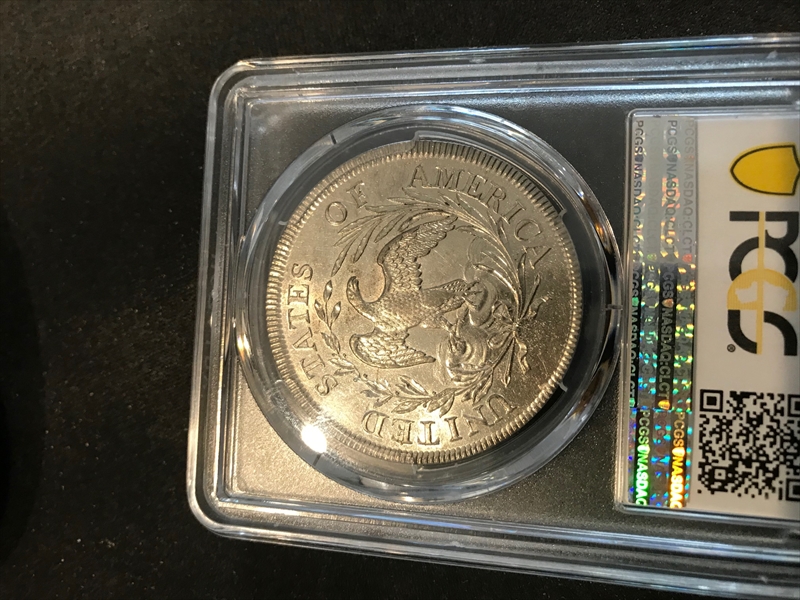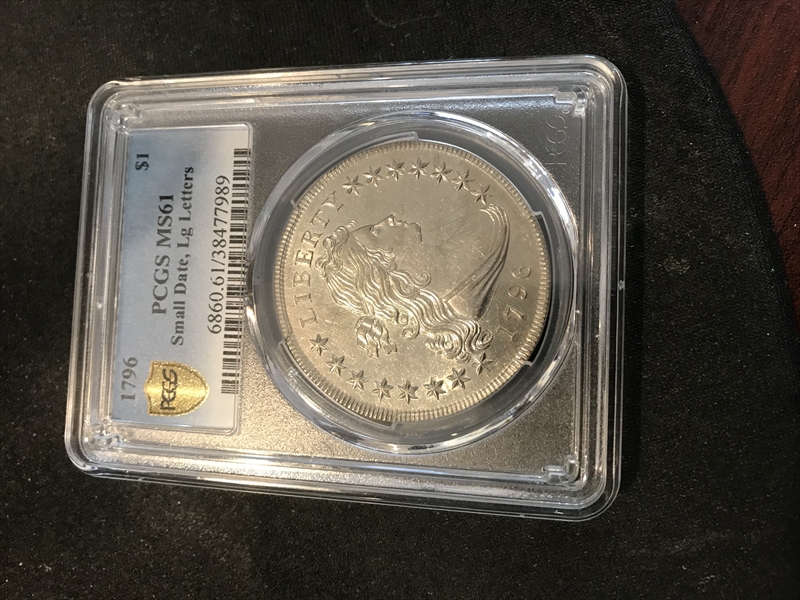1796 $1 BB-61 MS61 认证号38688959, PCGS号40000
专家评论
Q. David Bowers
The following narrative, with minor editing, is from my "Silver Dollars & Trade Dollars of the United States: A Complete Encyclopedia" (Wolfeboro, NH: Bowers and Merena Galleries, Inc., 1993). Note: the Notable Specimens list should be used with caution - it has been updated in my 2013 edition of "The Encyclopedia of United States Silver Dollars 1794-1804."(B-4. H-4.)
OBVERSE 1: Small, wide date with 96 close and 6 tipped to the left. Raised "dot" die flaw over 1 in date and closest to bust, tiny extra projection or flaw extending from the space at the bottom of star 11 (these flaws are visible on all die states given below). This and the obverse used to strike BB-66 were the first two obverse dies cut in 1796, and have the lower right tip of the R in LIBERTY intact.
Also see description under 1796 BB-62 (which is equivalent to Die State III described for BB-61).
Obverse die used to strike 1796 BB-61 (early state) and BB-62 (late state).
REVERSE A: Large letters in legend. Letters AMER crowded and touch at bases. Eight plain berries in wreath. Berry under first T in STATES. Two leaves beneath eagle's right (to observer's left) wing, these having been added by hand in front of the cloud. Small defect in field attached to two denticles below, and slightly left of, left ribbon end. From the same hub used to create 1795 BB-51 and 52, but on 1796 BB-61 not as strongly impressed, with the result that the eagle's breast feathers are not bold. Bolender mentions a die defect in the wreath extending to the right side of the M in AMERICA and the right wing tip.
Reverse die used to strike 1796 BB-61 only.
DIE STATES:
Die State I: Early state of the 1796 BB-61 die, described above. Top curl perfect; stars normal. Curl at top of forehead in the form of three or four arcs together. Lower curl nearest date boldly defined. The usually seen obverse die state. Walter Breen, in the John Reich journal; January 1987, stated that most specimens of 1796 BB-61 are of this die state, and that "over 10%" are of Die State II.
Die State II. Intermediate between I and III. Very lightly relapped at top of die. Top curl on head weaker, and detached at right. Curl at top of forehead now appears as two arcs, connected only at their tops. Lower curl nearest date boldly defined.
Die State III: Bolender-4a, showing the same die relapping effects as 1796 BB-62. Entire die relapped since Die State II. Curl on top of head defective, now tiny and detached. Curl at top of forehead now just a faint wisp. Some stars on the right smaller, the final two or three appearing spidery. Lower curl nearest date now very weak on side nearest date. In 1950, Bolender noted this: "Extremely rare. The only specimen I have found. From the John T. Reeder Collection. Mr. Reeder purchased it from Henry Chapman's sale of the Gable Collection." Since that time, numerous specimens have come to light. Walter Breen, in the John Reich Journal; January 1987, stated that "over 10%" of the specimens he had seen of [BB-61] are of Die State II, and that he had started observing this die state in 1955, and after seeing over 30 coins, he stopped counting. In my experience, at least 25% of 1796 BB-61 dollars are Die State II or, mostly, III.
COLLECTING NOTES: The 1796 BB-61 dollar is the most common variety of the year. An estimated 1,250 to 2,000 specimens exist. Most are in middle circulated grades, with VF being the median. EF coins turn up with regularity in dealers' stocks and auctions and make a nice "type" coin. In AU or better grade 1796 BB-61 is very rare. A few prooflike specimens exist, possibly made as presentation coins (cf. Walter H. Breen's Proof coins Encyclopedia, p. 35, where he states that he saw two pieces earlier, and "would like to see the pieces again to verify that they have the quality of surface and striking characteristic of actual presentation pieces of the period"). I am not aware of any special occasion in 1796 which would have called for prooflike silver dollars. However, prooflike quarter dollars of this date are often seen.
Due to unsatisfactory impressing of the eagle punch in the working die, specimens of 1796 BB-61 are not as well defined on the reverse as are most others of this general design type. Even AU and Mint State coins are apt to have the feathers appear "fuzzy" or indistinct. In worn grades the lack of detail on the eagle's breast feathers is even more apparent.
NOTABLE SPECIMENS:
Kagin Reference Specimen. MS-63. The finest known may be a prooflike piece once owned by A.M. and Paul Kagin (as part of a "1796 Proof set") and later advertised by Heritage in Coin World in August 1986. During the 1950s and early 1960s, the Kagins displayed the 1796 set as part of the Kagin Reference Collection.
CSNS Convention Sale Specimen. MS-60+. Kagin's, CSNS Convention Sale, 1979: 357. "Sharply struck Unc.-60++; full stars and hair strands, deep edge denticles, lovely pinkish brown lustre." Kagin's, 1980: 885. "Choice BU-63."
Aspen Specimen. MS-60+. Bowers and Merena, Nelson Page Aspen, M.D. Collection, 1989: 358. "MS-60 to 63. Both sides are nicely centered and are warmly toned in gorgeous, mottled hues of golden brown and electric blue. The fields are smooth and satiny and most of the design details are boldly defined. Some minor contact marks."
Newman Specimen. MS-60. Attractive surfaces with mottled blue and pale gold peripheral toning. Early state of the dies, equivalent to Die State I, above.
Newcomer Specimen. MS-60. Waldo C. Newcomer Collection. Col. E.H.R. Green Collection. James G. Macallister. T. James Clarke Collection, New Netherlands 48th Sale, 1956: 617. "Choice Uncirculated. Nicely centered and struck; slightly flat upon high points of eagle's head, breast, wings and legs. Pale blue toning with extensive golden lustre."
Alto Specimen. MS-60. Stack's, Alto Collection Sale, 1970: 1062, Brilliant Uncirculated. Full frosty mint bloom. The coin is well struck, having some light adjustment marks across the eagle's breast, and a thin tarnish streak on cheek.
Kagin's Tercentenary Sale Specimen. MS-60. Kagin's Tercentenary Sale, 1974: 605. "Bluish Uncirculated, sharper struck than most seen with only a few of the feathers not complete. A glass reveals microscopic handling marks."
Long Beach Sale Specimen. MS-60. Heritage, Long Beach Sale, 1989: 791. "Cleaned. Dullish silvery-gray surfaces which deepen to a charcoal and pinkish gold color about the devices. Nearly void of adjustment marks or noticeable distractions, with only minor weakness on eagle's breast and leg."
PCGS #
40000
设计师
Robert Scot/John Eckstein
边缘
Lettered: HUNDRED CENTS ONE DOLLAR OR UNIT
直径
40.00 毫米
重量
27.00 克
铸币数量
79920
金属成分
90% Silver, 10% Copper
更高评级数量
1
评级较低的钱币数量
48
地区
The United States of America
价格指南
PCGS 数量报告
拍卖 - PCGS 评级的
拍卖 - NGC 评级的
























